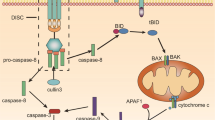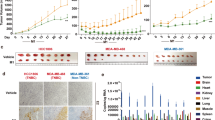Abstract
Tumor necrosis factor (TNF)-related apoptosis-inducing ligand (TRAIL), a member of the TNF family, is a type II transmembrane cytokine molecule. Soluble TRAIL has been shown to induce apoptosis in a wide variety of cancer cells in vitro and to suppress tumor growth specifically without damaging normal cells and tissues in vivo. In our previous report, we have demonstrated that an artificial gene encoding the polypeptide composed of the three functional elements (a secretion signal, a trimerization domain and an apoptosis-inducing moiety of TRAIL gene sequence) expresses and secretes highly apoptotic trimeric TRAIL into the culture supernatant. Here, as an approach to TRAIL-based cancer gene therapy, we developed an adenoviral vector delivering the gene that encodes our secretable trimeric TRAIL (stTRAIL). This adenovirus (Ad-stTRAIL) potently induced apoptosis in vitro in cancer cell lines such as HeLa, MDA-MB-231, A549, HCT116 and U-87MG. In an animal xenograft tumor model bearing a human glioma cell line U-87MG, intratumoral delivery of Ad-stTRAIL dramatically suppressed tumor growth without showing detectable adverse side effects. Histological analysis revealed that Ad-stTRAIL suppresses tumor growth by inducing apoptotic cell death. Contrary to the known rapid clearance of systemically delivered TRAIL protein from the blood circulation, stTRAIL expressed by Ad-stTRAIL in tumor tissues persisted for more than 4 days. In a comparison of tumor suppressor activity between Ad-stTRAIL and Ad-flTRAIL (delivering the full-length TRAIL gene) after mixing infected cells with uninfected cells and implanting these mixed cells in nude mice, Ad-stTRAIL showed higher tumor suppressor activity than that of Ad-flTRAIL. Our data reveal that a gene therapy using Ad-stTRAIL has a promising potential to treat human cancers including gliomas.
This is a preview of subscription content, access via your institution
Access options
Subscribe to this journal
Receive 12 print issues and online access
$259.00 per year
only $21.58 per issue
Buy this article
- Purchase on Springer Link
- Instant access to full article PDF
Prices may be subject to local taxes which are calculated during checkout






Similar content being viewed by others
References
Ashkenazi A, Dixit VM . Death receptors: signaling and modulation. Science 1998; 281: 1305–1308.
Nagata S . Apoptosis by death factor. Cell 1997; 88: 355–365.
Salvesen GS, Dixit VM . Caspases: intracellular signaling by proteolysis. Cell 1997; 91: 443–446.
MacFarlane M, Ahmad M, Srinivasula SM, Fernandes-Alnemri T, Cohen GM, Alnemri ES . Identification and molecular cloning of two novel receptors for the cytotoxic ligand TRAIL. J Biol Chem 1997; 272: 25417–25420.
Pan G, O'Rourke K, Chinnaiyan AM, Gentz R, Ebner R, Ni J et al. The receptor for the cytotoxic ligand TRAIL. Science 1997; 276: 111–113.
Sheridan JP, Marsters SA, Pitti RM, Gurney A, Skubatch M, Baldwin D et al. Control of TRAIL-induced apoptosis by a family of signaling and decoy receptors. Science 1997; 277: 818–821.
Hsu H, Xiong J, Goeddel DV . The TNF receptor 1-associated protein TRADD signals cell death and NF-kappa B activation. Cell 1995; 81: 495–504.
Hsu H, Shu HB, Pan MG, Goeddel DV . TRADD–TRAF2 and TRADD–FADD interactions define two distinct TNF receptor 1 signal transduction pathways. Cell 1996; 84: 299–308.
Liu ZG, Hsu H, Goeddel DV, Karin M . Dissection of TNF receptor 1 effector functions: JNK activation is not linked to apoptosis while NF-kappaB activation prevents cell death. Cell 1996; 87: 565–576.
Kelliher MA, Grimm S, Ishida Y, Kuo F, Stanger BZ, Leder P . The death domain kinase RIP mediates the TNF-induced NF-kappaB signal. Immunity 1998; 8: 297–303.
Boldin MP, Varfolomeev EE, Pancer Z, Mett IL, Camonis JH, Wallach D . A novel protein that interacts with the death domain of Fas/APO1 contains a sequence motif related to the death domain. J Biol Chem 1995; 270: 7795–7798.
Chinnaiyan AM, O'Rourke K, Tewari M, Dixit VM . FADD, a novel death domain-containing protein, interacts with the death domain of Fas and initiates apoptosis. Cell 1995; 81: 505–512.
Chinnaiyan AM, Tepper CG, Seldin MF, O'Rourke K, Kischkel FC, Hellbardt S et al. FADD/MORT1 is a common mediator of CD95 (Fas/APO-1) and tumor necrosis factor receptor-induced apoptosis. J Biol Chem 1996; 271: 4961–4965.
Juo P, Kuo CJ, Yuan J, Blenis J . Essential requirement for caspase-8/FLICE in the initiation of the Fas-induced apoptotic cascade. Curr Biol 1998; 8: 1001–1008.
Wiley SR, Schooley K, Smolak PJ, Din WS, Huang CP, Nicholl JK et al. Identification and characterization of a new member of the TNF family that induces apoptosis. Immunity 1995; 3: 673–682.
Pitti RM, Marsters SA, Ruppert S, Donahue CJ, Moore A, Ashkenazi A . Induction of apoptosis by Apo-2 ligand, a new member of the tumor necrosis factor cytokine family. J Biol Chem 1996; 271: 12687–12690.
Ashkenazi A, Pai RC, Fong S, Leung S, Lawrence DA, Marsters SA et al. Safety and antitumor activity of recombinant soluble Apo2 ligand. J Clin Invest 1999; 104: 155–162.
Walczak H, Miller RE, Ariail K, Gliniak B, Griffith TS, Kubin M et al. Tumoricidal activity of tumor necrosis factor-related apoptosis-inducing ligand in vivo. Nat Med 1999; 5: 157–163.
Ogasawara J, Watanabe-Fukunaga R, Adachi M, Matsuzawa A, Kasugai T, Kitamura Y et al. Lethal effect of the anti-Fas antibody in mice. Nature 1993; 364: 806–809.
Galle PR, Hofmann WJ, Walczak H, Schaller H, Otto G, Stremmel W et al. Involvement of the CD95 (APO-1/Fas) receptor and ligand in liver damage. J Exp Med 1995; 182: 1223–1230.
Cha SS, Kim MS, Choi YH, Sung BJ, Shin NK, Shin HC et al. 2.8 A resolution crystal structure of human TRAIL, a cytokine with selective antitumor activity. Immunity 1999; 11: 253–261.
Hymowitz SG, Christinger HW, Fuh G, Ultsch M, O'Connell M, Kelley RF et al. Triggering cell death: the crystal structure of Apo2L/TRAIL in a complex with death receptor 5. Mol Cell 1999; 4: 563–571.
Hymowitz SG, O'Connell MP, Ultsch MH, Hurst A, Totpal K, Ashkenazi A et al. A unique zinc-binding site revealed by a high-resolution X-ray structure of homotrimeric Apo2L/TRAIL. Biochemistry 2000; 39: 633–640.
Seol DW, Billiar TR . Cysteine 230 modulates tumor necrosis factor-related apoptosis-inducing ligand activity. Cancer Res 2000; 60: 3152–3154.
Trabzuni D, Famulski KS, Ahmad M . Functional analysis of tumour necrosis factor-alpha-related apoptosis-inducing ligand (TRAIL): cysteine-230 plays a critical role in the homotrimerization and biological activity of this novel tumoricidal cytokine. Biochem J 2000; 350 (Part 2): 505–510.
Kim MH, Billiar TR, Seol DW . The secretable form of trimeric TRAIL, a potent inducer of apoptosis. Biochem Biophys Res Commun 2004; 321: 930–935.
Griffith TS, Broghammer EL . Suppression of tumor growth following intralesional therapy with TRAIL recombinant adenovirus. Mol Ther 2001; 4: 257–266.
Jacob D, Davis JJ, Zhang L, Zhu H, Teraishi F, Fang B . Suppression of pancreatic tumor growth in the liver by systemic administration of the TRAIL gene driven by the hTERT promoter. Cancer Gene Ther 2005; 12: 109–115.
Denault JB, Leduc R . Furin/PACE/SPC1: a convertase involved in exocytic and endocytic processing of precursor proteins. FEBS Lett 1996; 379: 113–116.
Rieger J, Naumann U, Glaser T, Ashkenazi A, Weller M . APO2 ligand: a novel lethal weapon against malignant glioma? FEBS Lett 1998; 427: 124–128.
Song JH, Song DK, Pyrzynska B, Petruk KC, Van Meir EG, Hao C . TRAIL triggers apoptosis in human malignant glioma cells through extrinsic and intrinsic pathways. Brain Pathol 2003; 13: 539–553.
Alavi JB, Eck SL . Gene therapy for malignant gliomas. Hematol Oncol Clin N Am 1998; 12: 617–629.
Roth W, Isenmann S, Naumann U, Kugler S, Bahr M, Dichgans J et al. Locoregional Apo2L/TRAIL eradicates intracranial human malignant glioma xenografts in athymic mice in the absence of neurotoxicity. Biochem Biophys Res Commun 1999; 265: 479–483.
Frank DK . Gene therapy for head and neck cancer. Surg Oncol Clin N Am 2002; 11: 589–606, vi–vii.
Walther W, Stein U . Viral vectors for gene transfer: a review of their use in the treatment of human diseases. Drugs 2000; 60: 249–271.
Griffith TS, Anderson RD, Davidson BL, Williams RD, Ratliff TL . Adenoviral-mediated transfer of the TNF-related apoptosis-inducing ligand/Apo-2 ligand gene induces tumor cell apoptosis. J Immunol 2000; 165: 2886–2894.
Eck SL, Alavi JB, Judy K, Phillips P, Alavi A, Hackney D et al. Treatment of recurrent or progressive malignant glioma with a recombinant adenovirus expressing human interferon-beta (H5.010CMVhIFN-beta): a phase I trial. Hum Gene Ther 2001; 12: 97–113.
Zhu H, Zhang L, Huang X, Davis JJ, Jacob DA, Teraishi F et al. Overcoming acquired resistance to TRAIL by chemotherapeutic agents and calpain inhibitor I through distinct mechanisms. Mol Ther 2004; 9: 666–673.
Hardy S, Kitamura M, Harris-Stansil T, Dai Y, Phipps ML . Construction of adenovirus vectors through Cre-lox recombination. J Virol 1997; 71: 1842–1849.
Acknowledgements
We thank Sarah K McAshan and Michaele Armstrong for critical reading of the manuscript.
Author information
Authors and Affiliations
Corresponding author
Rights and permissions
About this article
Cite this article
Kim, CY., Jeong, M., Mushiake, H. et al. Cancer gene therapy using a novel secretable trimeric TRAIL. Gene Ther 13, 330–338 (2006). https://doi.org/10.1038/sj.gt.3302658
Received:
Revised:
Accepted:
Published:
Issue Date:
DOI: https://doi.org/10.1038/sj.gt.3302658
Keywords
This article is cited by
-
Advances and potential pitfalls of oncolytic viruses expressing immunomodulatory transgene therapy for malignant gliomas
Cell Death & Disease (2020)
-
A hypoxia- and telomerase-responsive oncolytic adenovirus expressing secretable trimeric TRAIL triggers tumour-specific apoptosis and promotes viral dispersion in TRAIL-resistant glioblastoma
Scientific Reports (2018)
-
TRAIL-receptor preferences in pancreatic cancer cells revisited: Both TRAIL-R1 and TRAIL-R2 have a licence to kill
BMC Cancer (2015)
-
TRAIL-secreting mesenchymal stem cells promote apoptosis in heat-shock-treated liver cancer cells and inhibit tumor growth in nude mice
Gene Therapy (2014)
-
Antitumor Effect of TRAIL on Oral Squamous Cell Carcinoma using Magnetic Nanoparticle-Mediated Gene Expression
Cell Biochemistry and Biophysics (2014)



